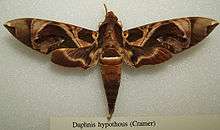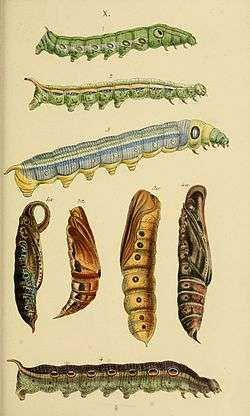Daphnis hypothous
| Jade hawkmoth | |
|---|---|
 | |
| Daphnis hypothous, mounted adult | |
 | |
| Daphnis hypothous, adult | |
| Scientific classification | |
| Kingdom: | Animalia |
| Phylum: | Arthropoda |
| Class: | Insecta |
| Order: | Lepidoptera |
| Family: | Sphingidae |
| Genus: | Daphnis |
| Species: | D. hypothous |
| Binomial name | |
| Daphnis hypothous (Cramer, 1780)[1] | |
| Synonyms | |
| |
Daphnis hypothous (jade hawkmoth) is a moth of the family Sphingidae. It is known from Sri Lanka, southern and northern India, Nepal, Myanmar, southern China, Taiwan, Thailand, Malaysia, and Indonesia. It is a rare vagrant to the Western Palaearctic ecozone.[2] During the last hundred years a number have been discovered within the Middle East and one was even found in Scotland late last century but this was probably imported as a pupa with cargo.[3]
Description
The wingspan is 86–120 mm. It is a very fast flyer and is attracted to both sweet-smelling flowers and light. It differs from Daphnis nerii in having the head and collar uniformly dark purplish-brown. Thorax and 1st two abdominal segments are dark green in color with a white fringe to the 1st segment. Other abdominal segments are dark olive-green in color with the streaks and spots as in D. nerii.[4]
Wings are similar to D. nerii but very much darker on both dorsal and ventral side. A white spot is present at the apex of fore wing and at the end of cell of fore wing o ventral side.
Larva is green in color with yellow dots at sides. There is a dark dorsal line, a subdorsal purple-red band, edged with yellow on thoracic somites and a blue ocellus on 3rd somite. Horn is purplish brown with white tubercles. Before changing to pupa, the larva becomes blotched with dark red in color.[5]

Larvae have been recorded feeding on Rubiaceae species, including Cinchona, Wendlandia and Uncaria species in India. Most instars are green with a brown backward curving tailhorn and a pair of white or red and yellow dorso-lateral stripes. Some instars have various coloured markings along the sides, including a blue eyespot on each side of the metathorax. The final instar is reddish brown.[6]
Caterpillars can be found on Breonia, Cinchona, Ixora, Pavetta, Uncaria, Wendlandia and Alstonia plants.[7]
Subspecies
- Daphnis hypothous hypothous (Indonesia including the Andaman Islands and Seram)
- Daphnis hypothous crameri Eitschberger & Melichar, 2010 (South-East Asia)
Related species
References
- ↑ "CATE Creating a Taxonomic eScience - Sphingidae". Cate-sphingidae.org. Archived from the original on 2012-10-26. Retrieved 2011-10-26.
- ↑ Pittaway AR; Kitching I. "Sphingidae of the Eastern Palaearctic". Tpittaway.tripod.com. Retrieved 2011-10-26.
- ↑ "Sphingidae of the Western Palaearctic". Tpittaway.tripod.com. Retrieved 2011-10-26.
- ↑ Hampson G. F. (1892). "The Fauna Of British India Including Ceylon And Burma Moths Vol-i". Digital Library of India. p. 558. Retrieved 4 July 2016.
- ↑ "Daphnis hypothous Cramer". The Moths of Borneo. Retrieved 6 July 2016.
- ↑ "Australian Insects". Lepidoptera.butterflyhouse.com.au. 2010-05-24. Retrieved 2011-10-26.
- ↑ "Daphnis hypothous". Butterfly House. Retrieved 6 July 2016.
External links
- Daphnis hypothous hypothous Sphingidae of the Eastern Palaearctic
| Wikimedia Commons has media related to Daphnis hypothous. |